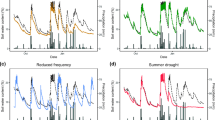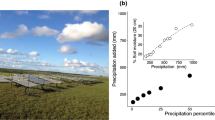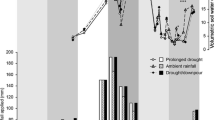Abstract
In water-limited grassland ecosystems, discrete and occasional precipitation events trigger brief but important episodes of biological activity. Differential responses of above- and below-ground biota to precipitation pulses may constrain biogeochemical transformations at the ecosystem scale. We examined the short-term dynamics of the whole ecosystem response to small precipitation events during 2003 and 2004 in a steppe on the Inner Mongolia Plateau. The results indicate that changes in soil moisture occur, with a 1–2 day time lag, only when the amount of precipitation exceeds 3 mm (from day of year [DOY] 120 to DOY 180) or 5 mm (after DOY 180). The interception of the developing plant canopy is a primary reason for the different temporal precipitation threshold. The lower threshold of effective rain is different between Net Ecosystem Exchange (NEE, 3 mm), Ecosystem Respiration (R e, 3 mm) and Gross Ecosystem Production (GEP, 5 mm). The NEE reached a maximum 4–5 days after the end of effective rain events and dropped to 60–70% of the original fluxes after 10 days. However, the drop in GEP was greater than that of NEE and reached 30–50% of the original fluxes after 10–15 days without “effective rainfall.” The characteristics of the response time can be attributed to the variation in soil water content and the time of readjusting for the ecological processes after the effective rainfall. In addition, the independent responses of photosynthesis, respiration and evapotranspiration to precipitation probably contributed to this time lag. The results support the hypothesis that the concept of an ecologically significant rainfall event can be developed for an ecosystem.







Similar content being viewed by others
References
Aubient M, Heinesch B, Longdoz B (2002) Estimation of the carbon sequestration by a heterogeneous forest night flux correction, heterogeneity of the site and inter-annual variability. Global Change Biol 8:1053–1071
Austin AT, Yahdjian ML, Stark JM, Belnap J, Porporato A, Norton U, Ravetta DA, Schaeffer SM (2004) Water pulses and biogeochemical cycles in arid and semiarid ecosystems. Oecologia 141:221–235
Baldocchi DD (2003) Assessing ecosystem carbon balance: problems and prospects of the eddy covariance technique. Global Change Biol 9:478–492
Beatley JC (1974) Phenological events and their environmental triggers in Mojave-Desert. Ecosyst Ecol 55:856–863
Cable JM, Huxman TE (2004) Precipitation pulse size effects on Sonoran Desert soil microbial crusts. Oecologia 141:317–324
Easterling DR, Meehl GA, Parmesan C, Changnon SA (2000) Climate extremes: observations, modeling, and impacts. Science 289:2068–2074
Falge E, Baldocchi DD, Richard O (2001) Gap filling strategies for defensible annual sums of net ecosystem exchange. Agric For Meteorol 107:43–69
Fay PA, Carlisle JD, Knapp AK, Blair JM, Collins SL (2000) Altering rainfall timing and quantity in a mesic grassland ecosystem: design and performance of rainfall manipulation shelters. Ecosystems 3:308–319
Fay PA, Carlisle JD, Knapp AK, Blair JM, Collins SL (2003) Productivity response to altered rainfall patterns in a C4-dominated grassland. Oecologia 137:245–251
Groisman PY, Karl TR, Easterling DR, Knight RW (1999) Changes I the probability of heavy precipitation: important indicators of climatic change. Clim Change 42:243–283
Hao YB, Wang YF, Huang XZ (2008) CO2, H2O and energy exchange of an Inner Mongolia steppe ecosystem during a dry and wet year. Acta Oecol 33:133–143
Harper CW, John MB, Philip AF, Alank K, Jonathan DC (2005) Increased rainfall variability and reduced rainfall amount decreases soil CO2 flux in a grassland ecosystem. Global Change Biol 11:322–334
Houghton JT, Ding Y, Griggs DJ, Nougure M (2001) Climate change 2001: the scientific basis. Contribution of working group 1 to the third assessment report of the intergovernmental panel on climate change. Cambridge University press, Cambridge, UK
Hunt JE, Kelliher FM, McSeveny TM, Byers JN (2002) Evapotranspiration and carbon dioxide exchange between the atmosphere and a tussock grassland during a summer drought. Agric For Meteorol 11:65–82
Huxman TE, Snyder KA, Tissue D, Leffler AJ (2004) Precipitation pulses and carbon fluxes in semiarid and arid ecosystems. Oecologia 141:254–268
Jiang S (1985) An introduction to the Inner Mongolia Grassland Ecosystem Research Station, Academia Sinica. In: Inner Mongolia Grassland Ecosystem Research Station (ed) Research on Grassland Ecosystem, vol 1, Science Press, Beijing, pp 1–11 (in Chinese with English abstract), 233 pp
Keeling RF, Whorf TP, Wahlen M (1995) International extremes in the rate of rise of atmospheric carbon dioxide since 1980. Nature 375:666–670
Kljun N, Calanca P, Rotach MW, Schmid HP (2004) A simple parameterization for flux footprint predictions. Boundary-Layer Meteorol 112:503–523
Knapp AK, Smith MD (2001) Variation among biomes in temporal dynamics of aboveground primary production. Science 291:481–484
Knapp AK, Fay PA, Blair JM, Collins SL (2002) Rainfall variability, carbon cycling, and plant species diversity in a mesic grassland. Science 298:2202–2204
Lauenroth W, Sala O (1992) Long-term forage production of North American shortgrass steppe. Ecol Appl 2:397–403
Le Houérou HN, Bingham RL, Skerbek W (1988) Relationship between the variability of primary production and the variability of annual precipitation in world arid lands. J Arid Environ 15:1–18
Noy-Meir I (1973) Desert ecosystems: environment and producers. Annu Rev Ecol Syst 4:23–51
Ogle K, Reynolds JF (2004) Plant responses to precipitation in desert ecosystems: integrating functional types, pulses, thresholds, and delays. Oecologia 141:282–294
Origans GH (1975) Diversity, stability and maturity in natural ecosystems. In: van Dobben WH, Lowe-McConnell RH (eds) Unifying concepts in ecology. Dr W Junk, B.V. Publisher, The Hague, pp 139–150
Potts DL, Huxman TE, Enquist BJ (2006) Resilience and resistance of ecosystem functional response to a precipitation pulse in a semiarid grassland. J Ecol 94:23–30
Reynolds JF, Kemp PR, Ogle K, Fernandez RJ (2004) Modifying the “pulse-reserve” paradigm for deserts of North America: precipitation pulses, soil water and plant responses. Oecologia 141:194–210
Sala OE, Lauenroth WK (1982) Small rainfall events: an ecological role in semiarid regions. Oecologia 53:301–304
Sala OE, Parton WJ, Joyce LA (1998) Primary production of the central grassland region of the United States. Ecology 69:40–45
Schwinning S, Sala OE (2004) Hierarchy of responses to resource pulses in arid and semi-arid ecosystems. Oecologia 141:211–220
Seastedt TR (1985) Canopy interception of nitrogen in bulk precipitation by annually burned and unburned tallgrass prairie. Oecologia 66:88–92
Smith SD, Monson RK, Anderson JE (1997) Physiological ecology of North American desert plants. Springer, Berlin
Smith SD, Huxman TE, Zitzer SF, Charlet TN (2000) Elevated CO2 increases productivity and invasive species success in an arid ecosystem. Nature 208:79–82
Wang J, Cai Y (1988) Studies of genesis, types and characteristics of the soils of the Xilin river basin. In: Inner Mongolia Grassland Ecosystem Research Station (ed) Research on Grassland Ecosystem, vol 3. Science Press, Beijing, pp 23–83 (in Chinese with English abstract)
Webb EK, Pearman GI, Leuning R (1980) Correction of flux measurements for density effects due to heat and water vapor transfer. Q J R Met Soc 106:85–100
Weltzin JF, Loik ME, Schwinning S (2003) Assessing the response of terrestrial ecosystems to potential changes in precipitation. Bioscience 53:941–952
Westman WE (1978) Measuring the inertia and resilience of ecosystems. Bioscience 28:705–710
Wiegand K, Jeltsch F, Ward D (2004) Minimum recruitment frequency in plants with episodic recruitment. Oecologia 141:363–372
Wilczak JM, Oncley SP, Stage SA (2001) Sonic anemometer tilt correction algorithms. Boundary-Layer Meteorol 99:127–150
Woodmansee RG., Vallis I, Mott JJ (1981) Grassland nitrogen. In: Clark FE, Rosswall T (eds) Terrestrial nitrogen cycles, vol 33. Ecol Bull, Stockholm, pp 443–462
Xiao XM, Jiang S, Wang YF (1996) Temporal variation in aboveground biomass of Leymus Chinense steppe from species to community levels in Xilin River Basin, Inner Mongolia, China. Vegetatio 123:1–12
Xu L, Baldocchi DD (2004) Seasonal variation in carbon dioxide exchange over Mediterranean annual grassland in California. Agric For Meteorol 1232:79–96
Acknowledgments
Financial support was subsidized by the National Key Basic Research Program (NKBRP) (Number: 2010CB833500) and the National Natural Sciences Foundation (NSFC) (Number: 30700079). We greatly appreciate the help from Inner Mongolia Grassland Ecosystem Research Station, The Chinese Academy of Sciences.
Author information
Authors and Affiliations
Corresponding author
Rights and permissions
About this article
Cite this article
Hao, Y., Wang, Y., Mei, X. et al. The response of ecosystem CO2 exchange to small precipitation pulses over a temperate steppe. Plant Ecol 209, 335–347 (2010). https://doi.org/10.1007/s11258-010-9766-1
Received:
Accepted:
Published:
Issue Date:
DOI: https://doi.org/10.1007/s11258-010-9766-1




